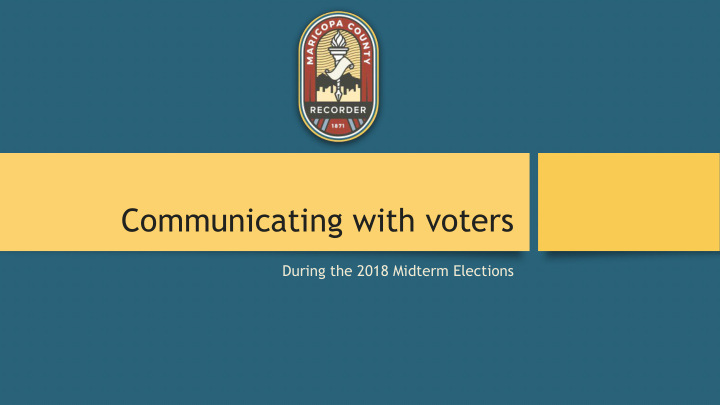



Communicating with voters During the 2018 Midterm Elections
How does the Recorder’s Office communicate with voters? • In person • Attending events • Voter Registration booths • Deputy Registrars • MCTEC/Downtown Office • Town Halls • MCTEC Tours
How does the Recorder’s Office communicate with voters? • By Phone: • STAR Center (Call Center Service) • MCTEC/Downtown Office • Through the website (Maricopa.Vote): • Frequently asked questions with answers are available on our website • An online form allows people with additional questions to contact the office • Surveys: • The Recorder’s Office sends surveys out to voters after Primary and General Elections • Post Election Report • https://bit.ly/2Dat4OP
How does the Recorder’s Office communicate with voters? • Social Media: • Facebook • Twitter • Instagram • LinkedIn • Used to increase awareness of: • Upcoming deadlines • Services provided by the office • Updates from the office • Job openings Graphic posted during the 2018 Midterm Election
Content on Social Media The following are examples of what was used to help educate voters: • Short videos with graphics: https://bit.ly/2UHtyrp • Myth Buster videos addressing election myths: https://bit.ly/2KQaWRw • Produced videos: https://bit.ly/2PeJNpX • Facebook Live: https://bit.ly/2Te3kHv • Graphics and Infographics https://bit.ly/2IPeAIA
Raising Awareness through Paid Advertising • We use paid advertising to reach out to voters during important periods leading up to the election. We use: • Newspapers ( AZ Republic, AZ Informant, East Valley Tribune Publications, Independent News Media ) • Digital ( Banner, Pay Per Click, Social Media ) • Online streaming services ( Hulu, YouTube )
Raising awareness using Television and Radio • TV ( Cable, ABC, NBC, PBS, Univision, Telemundo ) • Radio ( iHeart Radio, KTAR, NPR, Entravision )
How could the Recorder’s Office improve? • During the Primary Election, the communications department immediately noticed that more outreach was needed to inform early voters about what to do if they did not receive their ballot. • We notified people ballots were being mailed, but not what to do if it failed to arrive.
How lessons learned became best practices • For the General Election, the communications department provided more advance information on what to do if a voter did not receive their ballot. • We were proactive, letting people know how to replace their ballot if it was damaged by the rain, providing information to voters before ballots arrived.
What did the Recorder’s Office do well? • On Election Day, during the General Election, Recorder Fontes gave multiple live reports to both the press and those watching on social media. • After Election Day, we posted the number of ballots left to count for both the Primary and General Elections every day, until tabulation was completed. • Voters appreciated being informed in real time, and feeling like they were part of the process.
Ways to get involved 1.Take a tour of MCTEC: tinyurl.com/GetInvolvedMaricopa 2. Become a Deputy Registrar: tinyurl.com/DRclass2019 3. Fill out an interest form: Getinvolved.vote
Stay in touch fb.com/AdrianFontesMCR @recorderfontes & @maricopaelex @recorderfontes
Recommend
More recommend